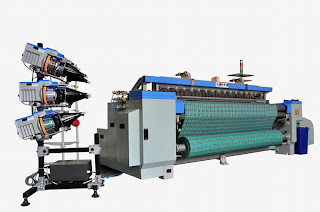 The air jet weaving machines are the weaving machines with the highest weft insertion performance and are considered as the most productive in the manufacturing of light to medium weight fabrics, preferably made of cotton and certain man-made fibres (sheets, shirting fabrics, linings, taffetas and satins in staple yarns of man-made fibres); it has anyway to be pointed out that technically positive results are obtained at present also with heavy weight fabrics (denims) and that some manufacturers produce also machine models for terry production. These machines are the ideal solution for those who want to produce bulk quantities of customized fabric styles.The weaving widths range generally from 190 to 400 cm. As regards the multicolour weft carrier, up to 8 different wefts can be fed.
The air jet weaving machines are the weaving machines with the highest weft insertion performance and are considered as the most productive in the manufacturing of light to medium weight fabrics, preferably made of cotton and certain man-made fibres (sheets, shirting fabrics, linings, taffetas and satins in staple yarns of man-made fibres); it has anyway to be pointed out that technically positive results are obtained at present also with heavy weight fabrics (denims) and that some manufacturers produce also machine models for terry production. These machines are the ideal solution for those who want to produce bulk quantities of customized fabric styles.The weaving widths range generally from 190 to 400 cm. As regards the multicolour weft carrier, up to 8 different wefts can be fed.
It has however to be considered that the air jet weaving machines require a high energy consumption to prepare the compressed air and that this consumption rises definitely with increasing loom width and running speed. The reduction in the energy consumption is in fact one of the main concerns of the manufacturers, and builds for the user an important selection criterion.
General operation
The thread, prepared in a given length (corresponding to the reed width) by pre-measuring weft carriers, is launched through the shed by a jet of compressed air.
The air jet weaving machines require air ducts capable of maintaining an effective air flow on the whole weaving width. To obtain this, the machine manufacturers prefer today to use the system with profiled reed, in which the air and the thread are guided through a tunnel-shaped reed.The weft is placed in the groove formed by the reed’s profiled dents, in which it remains until the reed stroke.

No comments:
Post a Comment